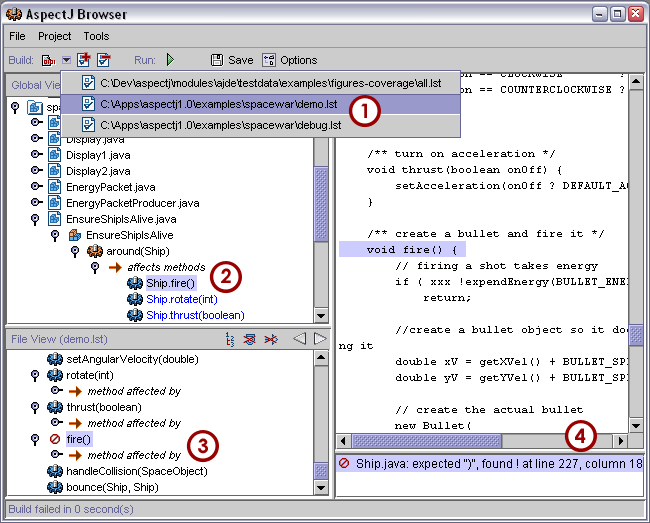AspectJ Browser
Name
AspectJ Browser — GUI tool for compiling programs with ajc and navigating the crosscutting structure (early-access)Overview
The AspectJ Browser is a development tool that will allow you to compile using ajc, navigate your program's static structure, edit source files, and graphically edit build configuration files.

To use the browser launch it by typing "ajbrowser" (assuming that
you've followed the instructions for setting up ajc). You can either pass in one or more
".lst" build configuration files as command line parameters to the
browser in order to build them and navigate the corresponding
structure, or you can open one or more ".lst" files with "File ->
Open" or with the "Open Build Configuration" button
( ).
).
Compiling a Build Configuration
To compile click the "Build" button
( ), or click <ctrl>F11. You may also select a
different build configuration here, as in label 1.
), or click <ctrl>F11. You may also select a
different build configuration here, as in label 1.
Navigating the Program Structure
Select nodes in the program structure by clicking them (as in label 2). If one node is related to one or more other nodes by an association the name of the association will appear below that node and will be displayed in italics. Links to other structure nodes appear in blue below the association. If there is no corresponding source for the link it will appear light-blue.
Manipulating Build Configuration
Build configurations can be manipulated adding, removing, and editing build configuration files using the corresponding toolbar buttons. The current configuration can be selected in the configurations listbox. Build configurations are represented by ".lst" files (which are described in the ajc documentation).
Example: Exploring the "Spacewar" sample code
- Choose "File -> Open" or click the "Open Build
Configuration" button
(
 ) and select the configuration file for debugging
the spacewar example, in
examples/spacewar/debug.lst.
) and select the configuration file for debugging
the spacewar example, in
examples/spacewar/debug.lst.
Click the "Build" button (
 ) to
compile. The left pane should fill with a spacewar declaration
tree. If there is a compiler error, the clickable error message
shows up as in label 4.
) to
compile. The left pane should fill with a spacewar declaration
tree. If there is a compiler error, the clickable error message
shows up as in label 4.
Note: If you did not install in the default location, the compile will fail with a message that you need to install aspectjrt.jar on your compile classpath. To do that, select "Tools -> Options" or click the "Options" button (
 ). Click the Build Options tab
to view the Build Paths pane. Edit the classpath entry to use your
install location, ok the dialog, and retry the compile.
). Click the Build Options tab
to view the Build Paths pane. Edit the classpath entry to use your
install location, ok the dialog, and retry the compile.

Different structure views: The structure tree at the left can display different orderings and granularity for structure:
- The package hierarchy view shows the traditional hierarchy of package, class, and members.
- The inheritance view shows the hierarchy from topmost parent classes through subclasses to members.
- The crosscutting view shows the aspect members and the code they affect.
- Additional buttons in the pane can be used to change the granularity and filter out items.
Whenever you select an item in the tree view, the source pane scrolls to that item. If you select a leaf item representing another program element, then the tree selection will go to the corresponding node. (See below for how to use two panes to maintain your place.)
When working with aspects, it helps to be able to navigate between different program elements:
You can view the advice on a particular method using the default, hierarchical view. Navigate to the tree item for spacewar.Registry.register(SpaceObject) in the debug.lst config file. Now, in the lower, file view, you can see and navigate to the advice using the subtree whose parent is the method affected by relation.
You can also use crosscutting view to see the advice using a pointcut or the methods affected by advice. For example, to see what advice uses a particular pointcut, navigate to the tree item for the pointcut spacewar.Debug.allConstructorsCut() in the debug.lst config file. You can see and navigate to the advice that uses the pointcut using the pointcut used by relation.
As an example of seeing the methods affected by advice, while still in the same view, select the first before advice in spacewar.Debug. It has relation sub-trees for both uses pointcut and affects constructions. The affects relations will list different kinds of join points - constructor or method calls, etc.